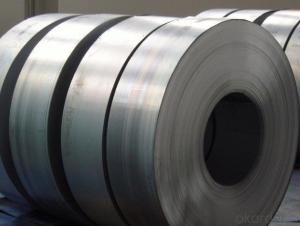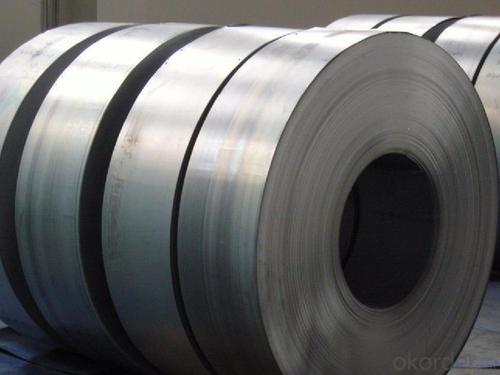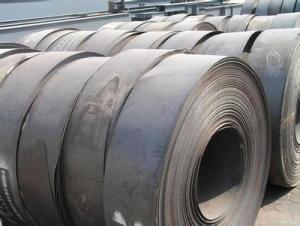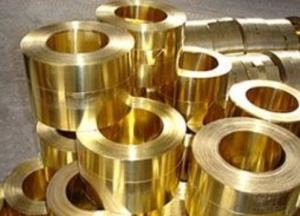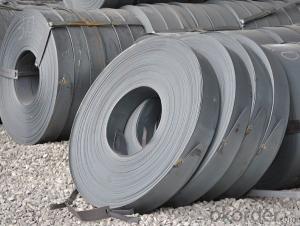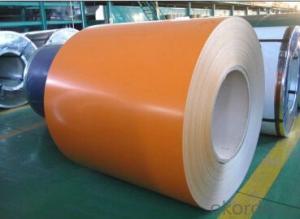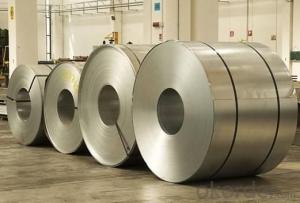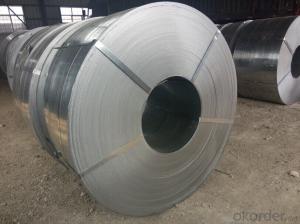Strip Steel Thin Size
- Loading Port:
- China Main Port
- Payment Terms:
- TT OR LC
- Min Order Qty:
- -
- Supply Capability:
- -
OKorder Service Pledge
OKorder Financial Service
You Might Also Like
Corresponding Steel Grade for Reference:
CHN, GB | JPN, JIS | GER, DIN |
50CrVA | SUP10 | 50CrV4 |
GBR, BS | FRA,FN | |
735A51 | 50CV4 |
Chemical Composition:
C | Si | Mn |
0.46~0.54 | 0.17~0.37 | 0.50~0.80 |
S | P | Cr |
≤0.030 | ≤0.030 | 0.80~1.10 |
Ni | Cu | V |
≤0.35 | ≤0.25 | 0.10~0.20 |
Mechanical Properties:
-Tensile Strength σb (MPa): ≥1274 (130)
-Yield Strength σs (MPa): ≥1127 (115)
-Elongation δ5 (%):≥10
-Percentage reduction of area: ψ (%): ≥40
-Hardness:
1, Hot rolled, ≤321HB
2, Cold drawn + Heat treatment: ≤321HB
-Norm of heat treatment:
1, Quenching: 850℃±20℃.
2, Cooled by oil.
3, Tempering: 500℃±50℃.
Usage/Applications
Mechanical Properties are good. 50CrVA have high hardenability. The element V reduces thermal sensitivity and improves the strength and toughness. The fatigue strength and yield point are high but the weld ability is bad.
-50CrVA is a nice material of spring. Usually it’s used as valve spring, piston spring and secure valve spring with big section that can bear much load. The working temperature is below 300℃
Packaging & Delivery
-Packing Detail: The products will be well packed.
-Delivery Detail: 30~45 working days after receive buyer’s T.T. or L/C.
- Q: Can steel strips be used in magnetic applications?
- Yes, steel strips can be used in magnetic applications. Steel is a ferromagnetic material, meaning it can be magnetized and exhibit magnetic properties. Steel strips can be used in various magnetic applications such as magnetic storage devices, transformers, motors, and sensors.
- Q: Can steel strips be galvanized?
- Yes, steel strips can be galvanized. Galvanizing is a process in which a protective coating of zinc is applied to steel to prevent it from rusting or corroding. This process can be done on various forms of steel, including steel strips.
- Q: What are the factors that affect the corrosion resistance of steel strips?
- The factors that affect the corrosion resistance of steel strips include the composition of the steel, the presence of impurities or alloying elements, the environment in which the steel is exposed to (such as moisture, temperature, and chemical exposure), the surface condition of the steel (such as surface finish or coatings), and the presence of any protective measures or inhibitors.
- Q: What are the main quality standards for steel strips?
- The main quality standards for steel strips include factors such as dimensional accuracy, surface finish, mechanical properties (such as strength and hardness), chemical composition, and uniformity in terms of thickness and width. These standards ensure that steel strips meet the required specifications, making them suitable for various applications in industries like automotive, construction, and manufacturing.
- Q: How are steel strips used in the production of automotive body panels?
- Steel strips are an essential component in the production of automotive body panels. These strips, which are usually made of high-strength steel, are used to provide structural integrity and durability to the body panels of vehicles. One of the primary uses of steel strips in automotive body panel production is in the manufacturing of the frame of the vehicle. Steel strips are cut into specific lengths and shapes, and then welded or joined together to form the frame structure. This frame serves as the backbone of the vehicle, providing support and stability to other body panels. Moreover, steel strips are also used in the fabrication of outer body panels such as doors, fenders, hoods, and roofs. These panels are typically stamped or pressed from steel strips using specialized machinery. The steel strips allow for precise shaping and forming of the body panels, ensuring that they fit seamlessly together and adhere to the desired design specifications. In addition to providing structural support and shaping, steel strips also contribute to the overall safety and crashworthiness of the vehicle. High-strength steel strips are used in critical areas of the body panels, such as the front and rear sections, to absorb and distribute impact energy during a collision. This helps to reduce the risk of injury to occupants and maintain the integrity of the passenger compartment. Furthermore, steel strips are chosen for their excellent corrosion resistance properties, which is crucial for automotive body panels exposed to various environmental conditions. The steel strips are often coated with protective layers or treated with anti-corrosion agents to prevent rust and enhance their longevity. In summary, steel strips play a vital role in the production of automotive body panels by providing structural support, shaping, crashworthiness, and corrosion resistance. They are a key component in manufacturing vehicles that meet safety standards, offer durability, and maintain aesthetics.
- Q: What are the surface finishing techniques for steel strips?
- There are several surface finishing techniques that can be employed for steel strips, depending on the desired final product and its specific requirements. Some of the commonly used surface finishing techniques for steel strips include: 1. Pickling: This technique involves the use of an acid solution to remove any oxide scale or impurities from the steel strip's surface. Pickling helps in improving the strip's corrosion resistance and prepares it for further processing. 2. Electroplating: It is a process wherein a thin layer of metal is deposited onto the steel strip's surface using an electrolytic bath. Electroplating can enhance the appearance of the strip, improve corrosion resistance, and provide additional properties such as increased hardness or conductivity. 3. Galvanizing: This technique involves coating the steel strip with a layer of zinc to provide protection against corrosion. Galvanizing is commonly used in applications where the steel strip will be exposed to harsh environments. 4. Painting: Applying a layer of paint onto the steel strip's surface can provide both aesthetic appeal and protection against corrosion. Different types of paint coatings can be used, depending on the specific requirements of the application. 5. Grinding and Polishing: These techniques involve the use of abrasive materials to remove any imperfections or roughness from the steel strip's surface. Grinding and polishing can provide a smooth and reflective finish to the strip, which is desirable in certain applications such as decorative or reflective surfaces. 6. Coating: Various types of coatings, such as powder coatings or organic coatings, can be applied to the steel strip's surface to provide protection against corrosion, enhance appearance, or provide specific functional properties. 7. Heat Treatment: Certain heat treatment processes, such as annealing or tempering, can be employed to modify the surface properties of the steel strip. These processes can improve hardness, strength, or other mechanical properties of the strip's surface. It is important to note that the choice of surface finishing technique for steel strips depends on factors such as the desired final properties, application requirements, cost considerations, and environmental impact.
- Q: What are the different surface defects found in steel strips?
- Steel strips can exhibit several surface defects, including scale, roll marks, scratches, pits, edge cracks, and surface contamination. Scale, an oxide that forms at high temperatures, appears as a flaky layer that can impact the steel's appearance and quality. Roll marks, caused by irregularities on the rolls used during manufacturing, create raised or depressed areas that affect flatness and appearance. Scratches, resulting from mechanical damage during handling or transportation, vary in size and depth and can impact appearance and integrity. Pits, small depressions or cavities, occur due to corrosion, handling damage, or manufacturing defects and affect appearance and structural integrity. Edge cracks, caused by improper handling, overloading, or manufacturing defects, weaken the steel's strength and integrity. Surface contamination, such as oil, grease, dirt, or paint, diminishes surface quality and may lead to corrosion or other damage. Detecting and addressing these defects is crucial to ensure the steel's quality and performance. Inspection methods like visual inspection, non-destructive testing, and surface treatment techniques are employed to identify and rectify these defects before using the steel in various applications.
- Q: How are steel strips coated with protective films?
- Steel strips are coated with protective films through a process known as steel strip coating. This involves applying a layer of protective material, usually through methods like hot-dip coating or electroplating, to the surface of the steel strips. The protective film helps prevent corrosion, improve durability, and enhance the overall performance of the steel strips in various applications.
- Q: What are the tolerances for dimensional accuracy in steel strips?
- The tolerances for dimensional accuracy in steel strips can vary depending on various factors such as the specific manufacturing process, the intended application of the steel strips, and the industry standards and regulations that govern the production. Generally, dimensional accuracy in steel strips is crucial to ensure their proper fit and functionality in various applications. The tolerances for dimensional accuracy in steel strips typically include measurements such as thickness, width, and length. For example, the thickness tolerance may range from a few micrometers to a few millimeters, depending on the desired precision and the specific requirements of the application. Similarly, the width tolerance may vary depending on the intended use, with narrower tolerances being necessary for applications where precise fit is essential. Length tolerance is another important factor, and it is usually specified to ensure that steel strips are cut to the desired length without significant deviations. This is particularly crucial in industries such as construction, automotive, and manufacturing, where precise dimensions are required for proper assembly and performance. It is important to note that different industries and applications may have their own specific tolerances for dimensional accuracy in steel strips. For instance, aerospace and automotive industries often demand higher precision and tighter tolerances compared to general manufacturing applications. In such cases, the tolerances may be specified in terms of tighter ranges, ensuring more precise and accurate dimensions. To determine the specific tolerances for dimensional accuracy in steel strips, it is advisable to refer to industry standards and regulations that outline the acceptable range of variations for different measurements. These standards are typically developed by recognized organizations and associations, taking into consideration the specific requirements and safety considerations of the industry. In conclusion, the tolerances for dimensional accuracy in steel strips can vary based on factors like manufacturing process, application, and industry standards. It is crucial to adhere to the specified tolerances to ensure proper fit, functionality, and safety in various applications.
- Q: How do you calculate the weight of a steel strip?
- In order to determine the weight of a steel strip, one must possess knowledge regarding the strip's dimensions as well as the density of the steel. The weight of a steel strip can be computed using the following equation: Weight = Length x Width x Thickness x Density Commence by measuring the length of the steel strip in any given unit of length, for instance, inches, centimeters, or meters. Proceed to measure the width of the steel strip, which should be perpendicular to the length, using the same unit of length as previously employed. Subsequently, gauge the thickness of the steel strip, constituting the third dimension, employing the same unit of length as aforementioned. Lastly, ascertain the density of the steel material. Keep in mind that the density of steel varies based on the particular type of steel employed, hence it might be necessary to consult a reference source or refer to the specifications of the specific steel strip being utilized. The density is typically presented in units of mass per unit volume, such as grams per cubic centimeter or kilograms per cubic meter. Once all the measurements and the density are known, insert them into the aforementioned formula. Multiply the length, width, and thickness together, followed by multiplying the resulting value by the density. The resultant figure will represent the weight of the steel strip in the unit of mass employed for the density. It is important to recognize that if the steel strip possesses any irregularities or variations in thickness, the weight calculation might not be entirely precise. Moreover, this formula assumes a uniform density throughout the entirety of the steel strip.
Send your message to us
Strip Steel Thin Size
- Loading Port:
- China Main Port
- Payment Terms:
- TT OR LC
- Min Order Qty:
- -
- Supply Capability:
- -
OKorder Service Pledge
OKorder Financial Service
Similar products
Hot products
Hot Searches
Related keywords
